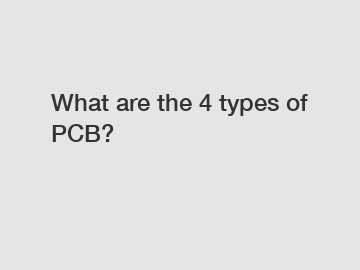What are the 4 types of PCB?
What are the 4 types of PCB?
Printed Circuit Boards (PCBs) have revolutionized the electronics industry and are widely used in various applications. These compact boards provide a foundation for electronic components to connect and operate seamlessly. But did you know there are different types of PCBs? In this article, we will explore the four main types of PCBs, their unique characteristics, and their applications.
1. Single-sided PCBs: .

Single-sided PCBs are the most basic type, with components and traces on only one side of the board. They consist of a single layer of substrate material, usually made of FR-4 or fiberglass. On the top side, a thin layer of copper is laminated, which forms the circuitry. Single-sided PCBs are commonly used in applications with low complexity and low-cost requirements, such as calculators, toys, and power supplies.
2. Double-sided PCBs: .
Double-sided PCBs are a step up from single-sided PCBs, offering two layers of substrate material and copper traces on both sides. The two layers are connected using vias, small holes that allow the electrical signals to pass through. This type of PCB provides more routing space, allowing for more complex circuit designs. Double-sided PCBs are widely used in consumer electronics, automotive applications, and industrial controls.
3. Multi-layer PCBs: .
When it comes to complex electronic devices, multi-layer PCBs come into play. They consist of three or more layers, with copper traces sandwiched between the layers of substrate material. These boards can have several layers, even reaching up to 16 or more in high-end applications. Multi-layer PCBs provide higher density, better performance, and enhanced signal integrity. They are commonly used in advanced computer systems, telecommunications equipment, medical devices, and aerospace applications.
4. Flex PCBs: .
Flex PCBs, also known as flexible PCBs or flex-rigid PCBs, offer flexibility and versatility that other types cannot match. They are designed with flexible layers of material, such as polyimide, enabling them to bend and twist without breaking the circuit. Flex PCBs are ideal for applications where space is limited, or where the board needs to conform to a unique shape. They are commonly found in smartphones, wearable devices, automotive interiors, and medical devices.
In conclusion, the four types of PCBs - single-sided, double-sided, multi-layer, and flex - cater to a wide range of electronic applications. Each type has its own distinct characteristics, providing solutions for different needs. From simple consumer electronics to advanced aerospace systems, PCBs have become an essential building block for modern technology. By understanding the different types of PCBs and their capabilities, designers and engineers can choose the most suitable option for their specific application requirements. So, next time you come across a electronic device, remember the crucial role PCBs play in making it work efficiently!
For more information, please visit security pcb assembly, security electronics pcb assembly, mintecelec.com.

Comments